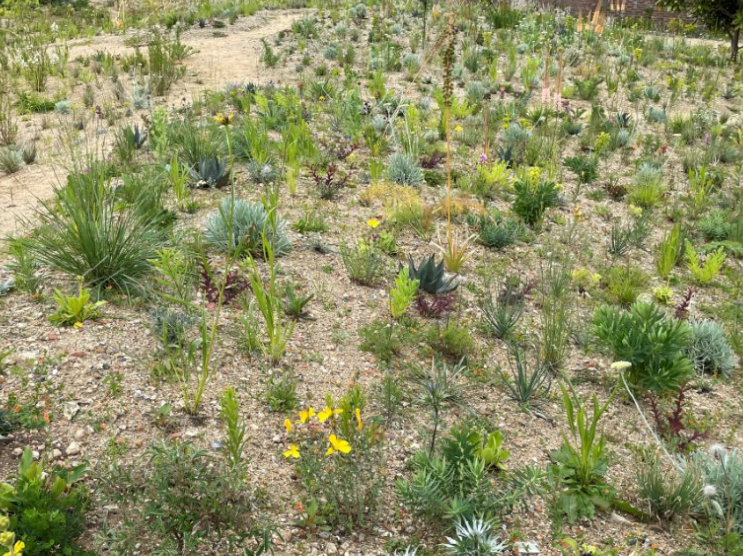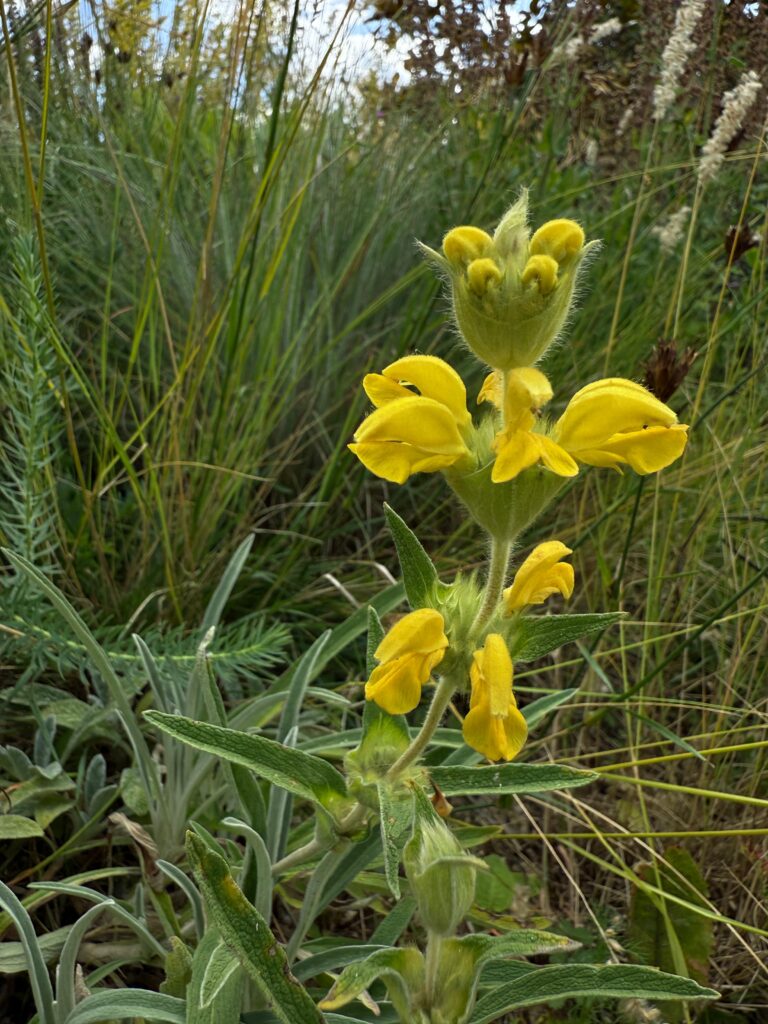
Episode 38: A Wild Way to Grow
PODCAST Episode 38: A wild way to grow It’s an early morning start for episode 38, as we meet with wonderful grower Rosanna before the
Home / Masterclasses and Heat Waves

Moy Fierheller | Deputy Head Gardener
Visit Knepp’s rewilded Walled Garden
Amid the spice and balm of wild rose blossom, the deep green of summer settles on the landscape. Rains at the beginning of the month have given the grass a verdant lushness, the shade of trees a cool wrap of air as the temperature begins to rise.
In the garden, James Hitchmough, landscape architect, delivered a Garden Masterclass workshop. James is a recent recipient of the Society of Garden Designers Lifetime Achievement Awards and is the designer responsible for the plant choices along the most free-draining, nutrient-poor ridge of the Rewilded Garden. In its fourth year, the sloping crushed concrete and sand mix is in full humming vibrancy: a burst of colours, flowers and leaf shapes, fluffy seedheads and waving clumps of grasses, flying and bustling insects.

James delved into the technicalities of his design – a matrix of plants chosen for their ability to thrive in harsh conditions, hailing from habitats such as dry, stony riverbeds, nutrient-poor prairielands and mountain scree. His familiarity with the behaviour of the plants, how tall or wide they grow and over what period, when they emerge and flower, when they die back or retain their structure through the seasons, dictated how and in what numbers they were grouped. Some were selected for their reliable performance: plants such as golden oat grass (Stipa gigantea), Siberian spurge (Euphorbia seguieriana subsp. niciciana), the two species of king’s spear (Asphodeline liburnica, A. lutea), bloody cranesbill (Geranium sanguineum ‘Max Frei’), and the little bluestem grass (Schizachyrium scoparium ‘Ha Ha Tonka’). These were distributed at suitable intervals in the original planting plan as small 9cm pots or bare root.
Walking through the garden now, James noted one of the stalwarts in his design, immortelle (Helichrysum orientale), is behaving in an unexpected way, larger and faster growing, leading him to think that what was delivered differs slightly in its provenance from the species he was expecting. It may have been that the cutting from which the stock was grown was taken from a different habitat than that which James was familiar with. These silver-leaved, low-mounded sub-shrubs from North Africa and the Mediterranean basin do a lot of work in the dark winter days, giving structure and light, acting as a backdrop to standing dead seedheads and grasses. Right now, they are like full stops between babbling, busy sentences.
Laid over the planting in the winter of 2021 was a seed mix of James’ devising. Some seeds were repeats of a few of the 9cm pot planting to give a sequence of generations, others were indicator species – they would only grow in these kinds of conditions, and their success would indicate that we had successfully recreated the right habitat for the plant choices. Others were chosen for their short-lived, but eye-catching qualities, flowering while slower-growing plants in the mix were establishing. The most obvious being the large-flowered delphinium (Delphinium grandiflorum), which smothered the ridge in stunning Majorelle blue in 2022 and of which we have only one specimen this year.

Others were what might be termed a ‘punt’. They may or may not make it. Austrian dragon head (Dracocephalum austriacum), a mountain herb from the mint family with blue salvia-like flowers, has remained elusive. This year, many of the seeds have reached a boisterous teenage maturity. The flattened, off-white cauliflower-like flowerhead of moon carrot (Seseli gummiferum), is asserting itself at thigh height. Yellow-flowered horseshoe vetch (Hippocrepis comosa) is sprawling over any number of other plants, regardless of their habits, and wild carrot (Daucus carota) can only be described as rife.
James’ plant selection acknowledged the evolutionary strategy of individual plants, based on the ecologist J.P. Grime’s ‘CSR triangle theory’ which divides plants into three categories based on their lifecycles: ‘competitors’ (which thrive in low-stress, low-disturbance environments), ‘stress-tolerators’ (which dominate in high-stress, low-disturbance environments), and ‘ruderals’ (which flourish in low-stress, high-disturbance areas). Knowledge of CSR theory can help with the design of balanced plant communities in different growing environments. The harsh conditions of ‘Hitchmough Ridge’ will suit the stress-tolerators best. The garden has no ‘end’ point and, as in nature, there will be a constant rise and fall of species, a dynamism that is key to supporting a diverse range of wildlife. Our job as herbivore proxies is to continue our work as ‘agents of disturbance’ grazing out plants that are in plentiful supply. James’ major impression was that, despite a drop in diversity from the original plant list, mainly from too much exuberant growth and loss of clear ground, “the visuals are sensational”.
Many of the Mediterranean shrubs are contributing to the overall visual impact of the Rewilded Garden this year, having reached a level of maturity that gives a greater profusion of flowers and adds a middle layer to the structural complexity of the planting. We have twelve species of Phlomis on our original plant list, although the genus boasts a hundred shrub and herbaceous species from the Mediterranean and eastwards into China. On ‘Hitchmough Ridge’ it is the less common blush-pink flowered Balearic Island sage (Phlomis italica) – from the group of islands off the Iberian Peninsula that includes the famed Ibiza – that has thrived. The dry and sunny spring seems to have favoured the growth of Phlomis lychnitis, with many more of its bright crayon-yellow flowers arranged in whorls at intervals along the stems that splay out from its thin and hairy, narrow silver leaves.

One of the reasons for the inclusion of so many sages, both the Salvia and Phlomis families, is their flower shape and relationship with insects. They are part of a group known as ‘complex’ flowers, with tube-like or fused petals. Unlike ‘simple’ flowers such as a buttercup, insects require a greater degree of motor skills and experience to access the pollen and nectar. These complex flowers have evolved to reward pollinators by producing greater quantities of nectar and, while fewer species of insects visit, those that do – often more long-lived or emerging early in the season – have more successful reproduction rates. Anecdotally, we’ve also noted how ‘hooded’ flowers are often used by insects as shelter in very cold or wet weather. So, the greater the diversity of flower shapes in a garden, mixing both complex and simple structures, the greater the benefit to pollinators, as well as the aesthetic interest for us.
One of the many simple flowered species that have the most extraordinary amount of blossom this year is the blackberry/bramble (Rubus fruticosus). It’s interesting to note that the common names immediately put the speaker in a ‘for’ or ‘against’ camp, but it is difficult to ignore their scent and the simple beauty of their five pure white petals surmounted by a frenzy of stamens – a cloud of brown dots. Often denigrated as indicative of ‘waste land’, characteristic of abandoned land, in the rewilding project at Knepp bramble has played a crucial role in the process of succession, as well as providing many benefits for wildlife. It is a pioneer species, improving soil quality and preventing erosion. It protects seedling oaks and sallow from the mouths of free roaming herbivores, and supports a range of fungi, insects, birds and mammals. Eventually its dominance has retreated as trees have matured and shaded it out and the soil has regained enough health to support more diverse vegetation.
We cultivate a horticultural species, ‘Oregon Thornless’, in the Kitchen Garden. It’s easier to crop and manage in its position against the east wall than the native plant, which hugs the perimeter on three sides on the other side of the wall and opportunistically finds niches in the top ridges of the brick to wave at us from above in tangled glee. Now the garden is reaching beyond the establishment phase perhaps it’s time to introduce the native, and graze it sufficiently harshly to prevent it taking over. With its long flowering nectar-rich blossom, it’s also ideal nesting habit, provides food for numerous moth and butterfly caterpillars and of course, gives us a crop of shining, juicy berries.
Towards the end of the month, as the days draw closer to our National Garden Scheme charity open day, the heat begins to build. The air is palpable, a thick, syrupy presence that crescendos to 33°C on the day itself. The planting, particularly in the Rewilded Garden, shows a stoic resilience. Most plants have already evolved in the harsh, often dry, conditions but we spot-water spring additions and the new sand mounds we created over winter. Despite most of the Kitchen Garden being beds of compost or topsoil-and-grit mixes, again, it was mainly the new, annual crops planted this spring that struggled in the hot spell. These we irrigated, along with the traditional annual veg beds which always get watered with drip lines.
We have periodically added more layers and complexity to this section of the garden over the last few years, demonstrating how plant density goes a long way in preserving humidity and preventing soils from drying out. Early in the season we dotted some leaf- mould mounds through the beds and these have successfully helped retain moisture. When clearing an area, we employ the ‘chop and drop’ technique (cutting leafy vegetation into small sections and dropping them in a layer round new seedlings) so very little soil is left exposed to the sun.
All in all, after a little last-minute path-hoeing to create some orderly frames, the garden was enthusiastically enjoyed by a few hundred visitors. We managed to raise over £2,000 which goes to nursing and health charities through the NGS, as well as supporting bursaries and funds for gardeners and community spaces. And an impressive army from our neighbours, the Friends of Shipley School, provided a constant supply of the all-important element of any garden open day – cake. Thank you to everyone who helped in the mammoth effort to make this day so enjoyable and successful.
You can visit Knepp’s rewilded Walled Garden
Moy’s Garden Tips for July:
Photos courtesy of Charlie Harpur and Moy Fierheller
What we’re reading:
Kourik,R, Understanding Roots, Metamorphic Press, 2015
Garden masterclass, Plants, Gardens, Landscape
(PDF) J. Philip Grime (1935–2021)

PODCAST Episode 38: A wild way to grow It’s an early morning start for episode 38, as we meet with wonderful grower Rosanna before the

PODCAST Episode 37: A Bonanza Year for Purple Emperors Join Knepp’s Isabella Tree and an over-excited Matthew Oates, the purple emperor’s No 1 devotee, to

PODCAST Episode 29: The Artists It’s Episode 29 and we’re visiting the beaver pen with a gaggle of delightful artists who help us draw a
Knepp Wildland Safaris, our gardens and campsite are all about the quiet and patient observation of nature.
Some of the species we are likely to encounter are shy or can be frightened by loud noises or sudden movements. Our campsite with open-air fire-pits, wood-burning stoves and an on-site pond is unsuitable for small children.
For this reason, our safaris, garden visits, holiday cottages and campsite are suitable only for children of 12 and over.